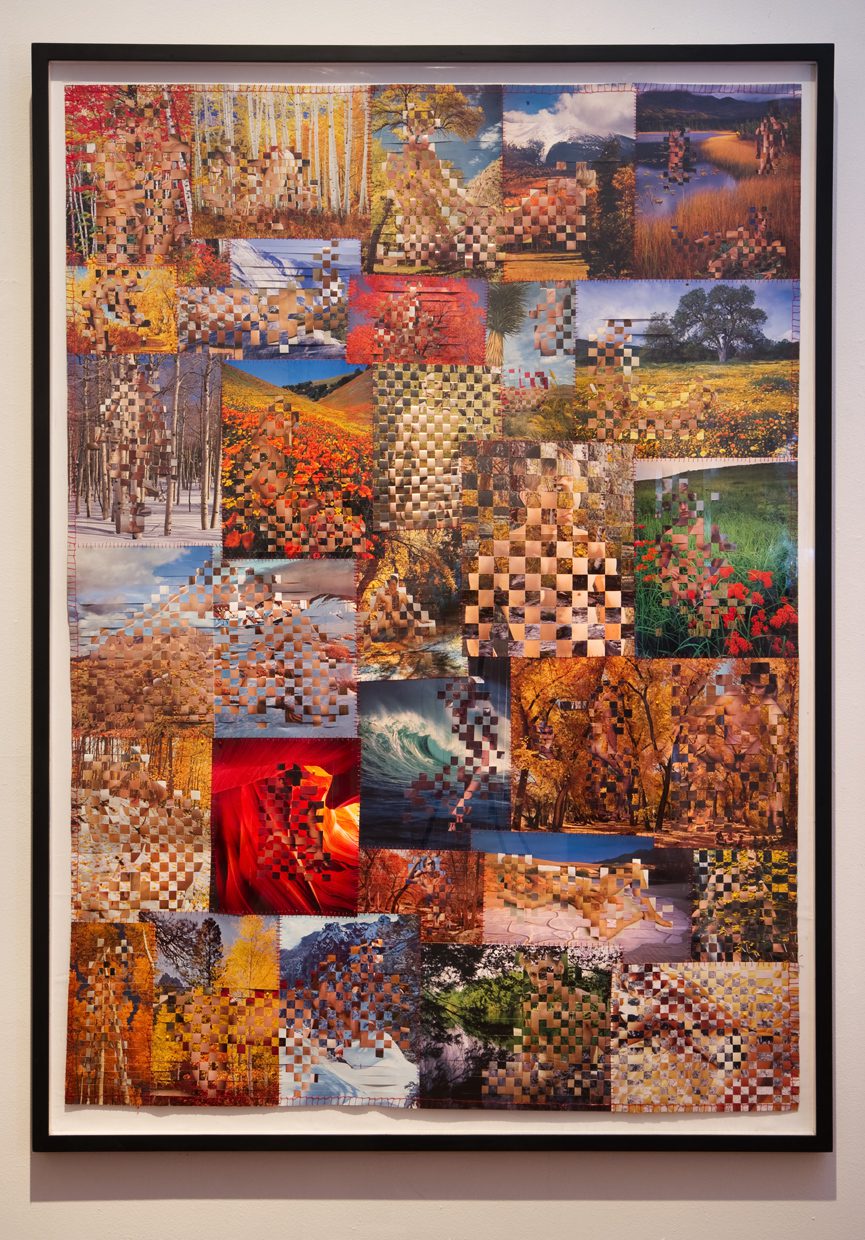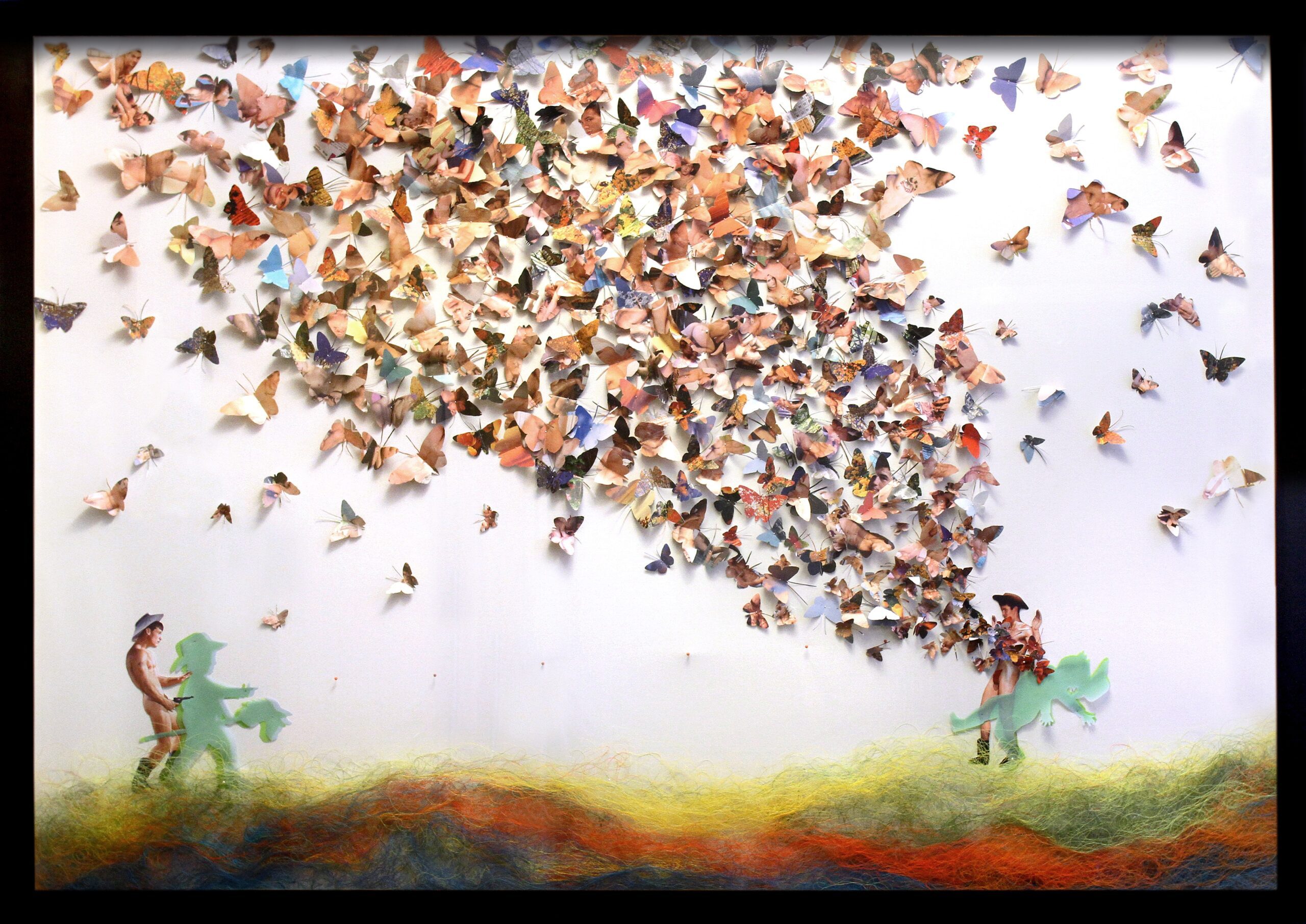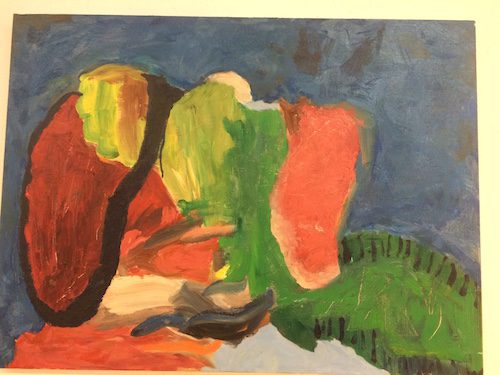Cristina García and Truong Tran are two Bay Area-based authors. García has written six novels, edited collections of stories, taught at MFA programs around the country, and has been awarded a Guggenheim Fellowship, a NEA grant and California Book Award, among others. Truong has published four books of poetry, teaches in the MFA programs at Mills College and San Francisco State University, and has been awarded a Creative Work Fund grant, The Fund for Poetry Grant, and a San Francisco Arts Commission Grants, among others. And both have shifted gears. While Truong is several years into his creative arts career and has had shows at CIIS, SOMArts, and Telegraph Hill Gallery, García is only a few weeks into her exploration of visual arts. I spoke to them about their transitions and explorations into visual arts, curious to know about the impetus behind their shifts and how visual arts have affected their consideration for language.
***
The Rumpus: I want to start with your writing because what I’m curious about is your trajectory from writing into visual arts. When did you start writing? Did you write as a kid?
Cristina García: I just kept diaries. I had to hide them from my mother but she looked for them and found them and I would get in trouble, which is why I made that huge diary [in an art class]. It was my first 3D art piece.
Truong Tran: When I look back on my writing now, I think that even when I was writing, I wanted to be an artist. But to be honest, growing up in an immigrant family, writing seemed more practical. Writing gave me more opportunities to promise my parents that I would go somewhere: I could study English and get a law degree. I clearly didn’t, but I kept on saying to my parents, you know, I can go to law school with an English degree. And then when I got to the MFA, my father just looked at me and said, “You’re never going to law school, are you?”
Rumpus: [Laughter]
Truong: Yeah, that’s about right.
Cristina García: I was actually a reader as a kid but I didn’t really write. I loved visual arts as a kid, and in 8th grade, I applied for the High School of Art and Design in New York. Which I got into, and then I wasn’t permitted to go.
The day that I went to the high school for the auditions—auditions isn’t the right word but I had to do a live drawing, have a portfolio together, it was an all-day thing. I was this little Catholic girl, twelve or thirteen, and I’d been to Catholic school pretty much my whole life, with matching knee socks and a little beret and the snap on ties. And I remember going around the school and there were people making out, the smell of pot was everywhere and I felt like I had crossed over into this very appealing world that was also kind of scary. But where did I end up? In an all-girls Catholic high school. Which was miserable. I got a terrible education. But anyway, basically, this is the interruption. The visual art was interrupted when I was thirteen and here I am, picking it up just as I’m turning fifty-eight. How many years is that? Forty-five years.
Rumpus: Tell me a little bit about your writing now. Truong, you write poetry.
Truong: I actually don’t think that I write poetry, I write in the space in between. It’s a hybrid form.
Rumpus: Between poetry and prose?
Truong: Yeah, and essay. And actually, the book that I am going to write next will feel like essays.
Rumpus: Are you working on this book right now?
Truong: It’s just notes right now.
Rumpus: Cristina, how did your journalism become fiction?
García: I was working for TIME Magazine as the Miami Bureau Chief. This was 1987 at the height of the Reagan era, in the bosom of what seemed to be monolithic political atmosphere there. I’d never been so shunned in my life as I was in Miami among the Cubans. I’d open my mouth and say something casual, like about Reagan or whatever. Literally, whoever was around me wouldn’t speak to me anymore. I thought, what the fuck is this? I had thought in a weird way it would be a kind of a homecoming. I mean, I understood the exile, the trauma, from my parents, but to be surrounded by it, that was a whole other order of asphyxiation.
This whole experience of that being an exile within an exile community, the experience of extreme alienation was something that I had never felt before—I mean, I grew up in New York, and then here I was in a place where I was a pariah among my own people, so called. It was so striking to me that I think that’s what made me want to start writing. At TIME, I was confined to 150 lines, one-page articles about this or that. That alienation just made me start questioning what I had taken for granted: who I was, where I belonged.
And also, I was reading a lot. You know, when I wasn’t reporting like a maniac, I literally sat in the bathtub and read. I’d just keep heating up the water and adding more bubbles. And I read. I read novels and then I started reading poetry for the first time. And then that’s when I caught fire. It was in Miami, in the bathtub that I caught fire [laughter]. And I started writing poetry, very bad poetry, but the poetry eventually morphed into what became Dreaming in Cuban.
Rumpus: As you built your writing careers, were visual arts always calling to you?
Truong: It took a pretty drastic moment to shift my thinking towards visual arts. I got to a moment in my writing career when I wasn’t trusting the language, I was really not trusting the written language, the English language. How do you work with a material that you don’t have trust in? I had to step away from it and find another way of articulating and I had to do it without words.
Rumpus: How did that lack of trust in language manifest? Was it that you couldn’t trust the language to convey what you meant?
Truong: The politics of language and the politics of writing really got to me. I’ve heard this phrase more than once now: this idea of the poetry wars, or the idea that people within the space of writing are at odds with one another or manipulating language to further one’s political stance, manipulating language in ways that really felt dirty to me. All of these things worked their way into and through language for me. It just—here I am working with that as a material to create my art. I had to step away from that. I still wrote for myself but I was writing into a space and a condition that was against the academic framework.
That was the other thing. I was working within the academy, writing work that is being read by the academy, and it just felt really limiting, so that’s why I said, hold on, let me do something else. I’m going to make art.
García: So I had a forty-five year interruption, essentially. And what I’ve done in that time is to always go to galleries, to see what’s happening. That’s the thing that I do when I’m not writing. I’m out looking at art, I have artist friends, so this is how I kept the arts in, in a “look but don’t touch” kind of way. I think that I’m just trying to reclaim it a bit.
Rumpus: What was the impetus for you to move into visual arts?
García: In 1992, Dreaming in Cuban came out and my daughter, Pilar, was born. It was a big year. My whole writing life is also my whole mothering life, the two completely dovetailed. I had to think creatively in terms of the books but I also had to think practically in terms of teaching and my time. I’d been thinking about it, the arts. When my daughter was little I once signed up for a pottery class, but there was always stuff in the way. I was mostly a single mother and I had to earn a living and I had to make sure she was okay and I put her through college. I had no margin. The writing life completely fused with the mothering life. And then I was moving around: to get her through college, I was taking jobs in Texas. I lived in Texas for five years when she went to college and I worked at three different universities putting her through college and there just wasn’t the time. But she graduated without debt.
When she was in college, I wrote this last book that’s set in Berlin. I finished the Berlin project a few months ago, early in the year. And then I’ve been busy teaching, and it sounds crazy, but I had to plan almost a year ago that I would not be taking on any new teaching jobs, not just locally but also no visiting professorships here or there. All that stuff is very disruptive to writing. And then I had to accept—and this is probably the hardest thing of all—I had to accept a semi-dependent state with my husband. Which I have never, ever done. I have always, since I left home at nineteen or twenty, I have always, always supported myself, and then myself and my daughter. When the last paychecks came in from St. Mary’s and San Jose State, I think I had a nervous breakdown.
I have a little income coming in, but aside from that, this is what it is. So it’s like now or never, you know?
Rumpus: What was your first piece? Or, how did you start?
Truong: The first piece that I made was an offshoot of these butterfly pieces [gestures to a framed box piece with cutout butterflies in it]. My art-making practice is that I go for these long walks and I gather materials, then I come home and I compose with the materials.
On one given day, I was walking down the street and my neighbor was out with a substantial box of gay porn magazines that he was throwing away. I asked him what he was doing and he said that he was “cleaning out his life.” There was something about that statement stayed with me and I said, “Let me take it from you,” and I took it and put it in my basement. I didn’t know what I was going to do with it, but I kept it there. It was an amazing collection because he had taken it apart and fully sorted and categorized it into different types of porn.
And then one day, doing that walk that I do, I ran into another neighbor and he told me that my neighbor, the one who gave me the box, had passed away. I immediately knew what I was going to do with it when that happened. I also had lots and lots of old nature calendars that I had been collecting and I took the porn and the calendars and I cut them into strips and wove them together into a quilt. That quilt was made for my neighbor. I was being pretty literal about it: the passing of time.
But, I also wanted to honor the fact that someone took so much time and effort to do this collecting thing, this sorting and categorizing, even if the material could be deemed in segments of our society as deviant material. I just thought that it was so beautiful. Also, it touched me, on a very historic level—personally historic—as a gay man, I wanted to honor that part of myself, but also honor my neighbor doing his own kind of work. So I made a quilt for him. Then, once I did that, what I realized about porn is that the material is very charged and that people bring all of their own consciousness and baggage to it. You put it up on a wall and everyone comes at it differently. It had an energy to it that I wanted to continue to explore. I started to cut butterflies. In Damien Hirst’s retrospective at the Tate, he built a room in which he released all these butterflies. People would walk in to see the sculptures and would step on the butterflies and they died. They kept count of how many butterflies he killed in that retrospective and it turned out to be nine thousand butterflies. Nine thousand.
Uuurgh.
And that’s not all that he’s done. He’s done amazing looking stained glass pieces but if you look closely you realize that all of the stained glass colors are actually made from butterfly wings. He farmed his own butterflies, pulled the wings off the butterflies, repositioned them as colors for a piece of stained glass.
Rumpus: So did your butterflies come from that idea or—?
Truong: The idea came from wanting to call him out and say what an asshole, what a dick he was. So I started to cut butterflies out of assholes and dicks.
That was how the material found its second life. I just started to meditate on that, cutting butterflies out of assholes and dicks. I got exhausted by that process, I needed to cut other things. I started to cut nature into them; it made sense to me to use colors of nature and bring nature back into this conversation in consideration of the “work” [Damien Hirst’s]. I made a goal of cutting out nine thousand butterflies.
Rumpus: And did you?
Truong: I did. And I still cut butterflies. There is something very meditative about it.
Rumpus: After you made the quilt, did that just open up making visual art for you?
Truong: It did. And also the fact that that I didn’t think that I could return to the written word so I kept on going, further and further into my visual arts work.
Rumpus: Cristina, tell me about your shift into visual arts.
García: Writing books, I did all this work and at the end of it I have boxes and boxes of stuff that all looks the same. In just the few weeks that I’ve thrown myself into this painting, I think, oh my god, what is all this stuff? I feel like my own Sherpa, carrying around all this stuff, these boxes of drafts and notes that all looks the same. Everything I do in art is visible and these drafts, no one can see what it is just by looking. I feel like for the twenty-five years or more that I’ve been writing, I’ve led this gnome-ish existence. Like I’ve been in my cave, all gnarled and irascible, hiding.
But now, everything I make, there’s evidence, a terrible but fun evidence. I realize now that the invisibility, ultimately, of the writing was a way to protect myself. In a sense, reading was a hideout. No one could access it, no one knew if I was doing my homework, you know, or reading pornography. But if I had gone to the High School of Design, I would have been slammed down so hard because it would have been all visible. As it was with my mother and the stupid diary. Imagine, if I had been doing all this stuff that she could see. It became this thing for me unconsciously, a negotiation between visibility and invisibility. Even now, you send your books out in the world and it’s completely anonymous. It’s a mass market product that goes out, and you’re there on the page but you’re not there in person, no one is staring at you, like at an art opening. With writing, every once in awhile you come out of your cave and you do a reading but other than that, it really is very anonymous.
Visual art to me feels like chronic exposure syndrome, everything is wonderfully, terribly visible. I’m kind of electrified by the visibility.
Rumpus: Has your arts practice changed how you teach, how you read?
García: It’s too early for me to know yet.
Truong: It slows things down. I think because of the practice making with your hands it slows things down. So the reading feels slowed down for me. I appreciate that.
I also had gotten to the point where it was really hard for me to read something and not come at it with the critical eye. It was just the thing that I did. I was reading students’ work, or I was reading other academic works, and every time that I encountered something it was through that lens that was very academically trained. I had to unlearn some of that, to come back to language and to love it.
You know how that feels, to love language. It can be taken away from you.
I teach poetry through the lens of visual arts now. I am less interested in other writing as a point of reference for the students because I want to make the connection to other art forms. For example, when Kara Walker projects light in a museum space and projects your shadow onto the wall alongside other silhouette cutouts, you become a part of the art in that moment. And she says, I am doing that because—often she makes art that is about the slave narrative but she says, I am projecting light, I am projecting your shadow on to that space because it’s a history and we’re all implicated in the history. I thought that was really interesting to hear. And to then process that and think about how it’s a shared history. As a Vietnamese immigrant in this country teaching writing, I can’t help but inherit the history of slavery. It informs how I exist in this world now. That was a moment of epiphany for me to hear someone talk that way when Kara Walker talked about it, and it’s a consciousness that translates and carries into writing. So I do think like that. I look for ways of thinking from visual artists and I find ways to connect it to the writing practice. I’m actually teaching a class tonight at Root Division, which is a visual arts space, but I am teaching a writing class, called Poetry Making, as opposed to “writing.”
Rumpus: Cristina, can you speak more about idea that you’re having to speak in a language that you don’t know?
García: I feel like I’m starting with the most basic of lexicons. And I’m having to gesture more than speak. Throw tantrums kind of thing. And you know, I’m hoping maybe by the end of the summer I’ll be in preschool and doing macaroni paintings. Right now, I’m just trying to acquire the vocabulary.
Yesterday, I had lunch with this artist friend of mine and she said, oh no, you should have a cobalt blue. I’m like, oh really? So then I went over to Blick with my little list and now I have four new colors that I’m playing with and mixing today. And so every day I try and add new vocabulary. My friend asked me, what about a fan brush? And I go, a fan brush? And she says, yes, you need a fan brush. So I got one and today I’m fanning away. It is completely hands on.
I don’t know what I’m doing and I’m groping forward and it’s very fun and I keep reminding myself that there is no goal here except the exploration the pleasure. I have no ultimate goal to produce anything. Anytime I start to think about that, which I don’t, actually, but before I started this, if I thought about making art, my throat felt like it would close up and I couldn’t even try. I remind myself that this is play for me and I have no nothing except the day.
Rumpus: Do you find that there are things that you can say with visual arts that you can’t with writing?
Truong: It was just so satisfying to create work that was beyond the framework of language. I think for me that when I make art, I allow myself the opportunity to think with my hands as well. The thing about writing is that you’re constantly grappling with every word, but here, because it is removed from the consideration of words in many ways, it can just allow you to move through the art. I discover things in the act of making.
Like writing, it’s an attempt to make sense of whatever it is that is floating around. And I think that the only way to make sense of what’s happening of what’s going, what’s swirling around you is to come at it from a very absurdist practice. You know, one could say that cutting nine thousand butterflies out of dicks and assholes is absurd but it makes perfect sense for me.
Rumpus: What do you mean when you say, “ways to facilitate my thinking,” Truong?
Truong: “Facilitate my thinking” means thinking about who I am as a human being in relation to the world around me. It’s how I position myself, how I navigate through this world. That to me is thinking. It is also exhausting to constantly be making art that in some ways responds to the conditions of the world around you. And so this summer, I gave myself permission to turn all of that off, and to lose myself in work.
Rumpus: How is losing yourself in your work different than when you are preparing for a show?
Truong: Usually when I prepare for a show, I prepare in response to something. I did an entire show based on the struggles of artists and people of color in the city who are being displaced. I did that work for a year and a half, just fully concentrating on that. I am in a very peculiar position right now, to be honest: I don’t have a show scheduled, I don’t have any commissions, I am not writing a book right now. My head is empty and it is nice. I want to do something that is completely detached from any call and response, call and response. I don’t know if that can sustain itself because the truth of the matter is that something like what happened this weekend [in Orlando] happens often and the only way that I know how to respond to that is to sit down and write something or to sit down and make something. So yeah, it is not easy because the external world is always coming at you.
Rumpus: Do you have any expectations for your unscheduled time to just create?
García: It’s all evolving; I don’t know what any of it will be.
Truong: There are days when I’m like, uuuuugh, I can barely move because of all this crap that is happening around me. In those moments, fiddling around with some of the materials, discovering what is hidden in those materials is enough to carry me from one day to the next.
***
Image 1: Christina García, Havana
Image 2: Truong Tran, A Quilt for Joe
Image 3: Truong Tran, Bang! Bang! Summer Bliss
Image 4: Cristina García, Undone









One response
The words are metamorhasizing into the physical -love it!
Click here to subscribe today and leave your comment.